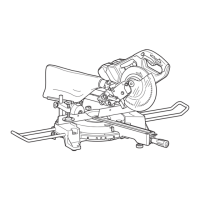2 ENGLISH
ENGLISH (Original instructions)
SPECIFICATIONS
Model: XSL02
Blade diameter 190 mm (7-1/2")
Hole (arbor) diameter 15.88mm (5/8")
Max. miter angle Left 47°, Right 57°
Max. bevel angle Left 45°, Right 5°
No load speed (RPM) 5,700 /min
Dimensions (L x W x H) 655 mm x 430 mm x 445 mm
(25-3/4" x 17" x 17-1/2")
Rated voltage D.C.36 V
Standard battery cartridge BL1815N, BL1820, BL1820B BL1830, BL1840, BL1840B, BL1850,
BL1850B
Net weight 12.6 kg (27.8 lbs) 13.1kg (28.9 lbs)
Max. Cutting capacities (H x W) with blade 190 mm (7-1/2") in diameter
Miter angle Bevel angle
45° (left) 0° 5° (right)
0° 40 mm x 300 mm
(1-9/16" x 11 - 3/4")
52 mm x 300 mm
(2 - 1/16" x 11 - 3/4")
40 mm x 300 mm
(1 - 9/16" x 11 - 3/4")
45 mm x 265 mm
(1 - 3/4" x 10 - 3/8") (NOTE 1)
60 mm x 265 mm
(2-3/8" x 10-3/8") (NOTE 1)
–
45° (left and right) 40 mm x 212 mm
(1-9/16" x 8 - 3/8")
52 mm x 212 mm
(2 - 1/16" x 8 - 3/8")
–
45 mm x 185 mm
(1 - 3/4" x 7 - 1/4") (NOTE 2)
60 mm x 185 mm
(2-3/8" x 7-1/4") (NOTE 2)
–
57° (right) – 52 mm x 163 mm
(2 - 1/16" x 6 - 3/8")
–
– 60 mm x 145 mm
(2-3/8" x 5-3/4") (NOTE 3)
–
1. Max. Cutting capacity when using a wood facing 20 mm (13/16") thickness
2. Max. Cutting capacity when using a wood facing 15 mm (9/16") thickness
3. Max. Cutting capacity when using a wood facing 10 mm (3/8") thickness
• Duetoourcontinuingprogramofresearchanddevelopment,thespecicationshereinaresubjecttochange
without notice.
• Specicationsandbatterycartridgemaydifferfromcountrytocountry.
• Weight, with battery cartridge, according to EPTA-Procedure 01/2003
For your own safety read instruc-
tion manual
Before operating tool
Save it for future reference
General safety precautions (For all
tools)
1. KNOW YOUR POWER TOOL. Read the owner's
manual carefully. Learn the tool's applications
and limitations, as well as the specic poten-
tial hazards peculiar to it.
2. KEEP GUARDS IN PLACE and in working
order.
3. REMOVE ADJUSTING KEYS AND WRENCHES.
Form habit of checking to see that keys and
adjusting wrenches are removed from tool
before turning it on.
4. KEEP WORK AREA CLEAN. Cluttered areas
and benches invite accidents.
5. DO NOT USE IN DANGEROUS ENVIRONMENT.
Do not use power tools in damp or wet loca-
tions, or expose them to rain. Keep work area
well lighted. Do not use tool in presence of
ammable liquids or gases.
6. KEEP CHILDREN AWAY. All visitors should be
kept safe distance from work area.
7. MAKE WORKSHOP KID PROOF with padlocks,
master switches, or by removing starter keys.
8. DO NOT FORCE TOOL. It will do the job better
and safer at the rate for which it was designed.
9. USE RIGHT TOOL. Do not force tool or

